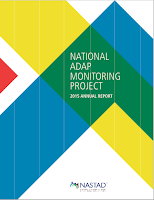Earlier this month the National Alliance of State & Territorial AIDS Directors (NASTAD) released its 2015 National ADAP Monitoring Project Annual Report. The report represents the most comprehensive annual analysis of the AIDS Drug Assistance Program (ADAP), including relevant data on the individuals seeking ADAP services, as well as the services being provided to them.
 |
| National ADAP Monitoring Project: 2015 Annual Report |
If there is one reoccurring theme that has emerged over the years at the ADAP Advocacy Association's Annual Conference -- and its various summits held across the county -- is the need for more timely data. For example, "There is a lack of baseline data available," was identified as a key assumption in our Final Report from the HIV/HCV Co-Infection Summit held in April 2013.
Even as some organization's are prematurely pushing for the reauthorization of the Ryan White CARE Act, others groups -- including the ADAP Advocacy Association -- want more data on the ACA's impact on the program and the clients it serves before opening up the law.
The bottom line: data is key! To that end, NASTAD should be commended for its work on providing ADAP-related data to the HIV/AIDS advocacy community.
According to NASTAD[1], among the key findings:
- ADAP enrollment reached its highest level in the program’s history, with over 258,000 clients enrolled in FY2013 (April 1, 2013 – March 31, 2014).
- ADAPs reported spending over $110.7 million on insurance purchasing/continuation in June 2014; 61,456 (42%) ADAP clients were covered by such arrangements. By comparison, ADAPs used $27.6 million in June 2013 for insurance purchasing/continuation.
- The majority (63%) of all clients served by ADAPs in June 2014 were reported as virally suppressed, defined as having a viral load that is less than or equal to 200 copies/mL. By comparison, thirty-percent (30%) of all people living with HIV (PLWH) in the U.S. are reported as virally suppressed.
Of particular interest to the ADAP Advocacy Association, ADAPs continue to play a pivotal role in ensuring low-income patients living with HIV/AIDS with little or no health insurance have access to the timely, appropriate care that they deserve. Whereas ADAP enrollment decreased 3% from June 2013 to June 2014 (210,411 patients enrolled and 204,988 patients enrolled, respectively), it nonetheless provided life-saving medications to hundreds of thousands of individuals.[2]
Not surprisingly, ADAP continue to thrive in the South...especially since most of the states in this region of the country have not expanded their Medicaid programs under the ACA. Among southern states, only Georgia witnessed a decreased in its ADAP enrollment (-0.03%). All of the other states saw increases in their ADAP enrollment, including an 8% increase in Alabama, 4% increase in Arkansas, 7% increase in Florida, 27% increase in Louisiana, 3% increase in North Carolina, 5% increase in South Carolina, 10% increase in Tennessee, 6% increase in Texas, and 4% increase in Virginia. Mississippi didn't not provide data on its enrollment.[3]
One thing is clear from NASTAD's 2015 National ADAP Monitoring Project Annual Report: ADAPs continue to provide an important safety net of last resort. This year's report, along with other ongoing data collection reports, provide the patient advocacy community with plenty of ammunition to educate policy-makers on the important of the AIDS Drug Assistance Programs, as well as other programs assisting under-served communities.
CLICK HERE to download the National ADAP Monitoring Project: 2015 Annual Report.
_____________
[1] National Alliance of State & Territorial AIDS Directors, "FINDINGS OF THE 2015 NATIONAL AIDS DRUG ASSISTANCE PROGRAM (ADAP) MONITORING PROJECT ANNUAL REPORT," May 12, 2015.
[2] National Alliance of State & Territorial AIDS Directors, "2015 National ADAP Monitoring Project Annual Report, Table 6: Total Clients Enrolled and Served, June 2013 and June 2014," p. 46, May 12, 2015.
[3] National Alliance of State & Territorial AIDS Directors, "2015 National ADAP Monitoring Project Annual Report, Table 6: Total Clients Enrolled and Served, June 2013 and June 2014," p. 46, May 12, 2015.


No comments:
Post a Comment